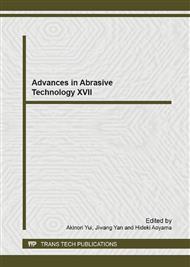p.532
p.539
p.544
p.549
p.553
p.559
p.565
p.573
p.580
Micro-Cracks Removal on Edge Surface of Thin Glass Sheet Using Magnetorheological Finishing
Abstract:
Micro-cracks on the edge surface of thin glass edge sheet have been identified as a key factor of catastrophic glass breakage. Hence, their removal will strengthen the thin glass substantially. This paper studies the glass edge finishing using magnetorheological finishing (MRF). The thin glass sheet edge is finished by shear force exerted by magnetorheological fluid, which is magnetically held by a specially designed magnetic wheel tool. All micro-cracks can be removed from the edge surface and the surface roughness improves from Ra 0.5 μm to Ra 0.03 μm.
Info:
Periodical:
Pages:
553-558
Citation:
Online since:
September 2014
Authors:
Keywords:
Price:
Сopyright:
© 2014 Trans Tech Publications Ltd. All Rights Reserved
Share:
Citation:


